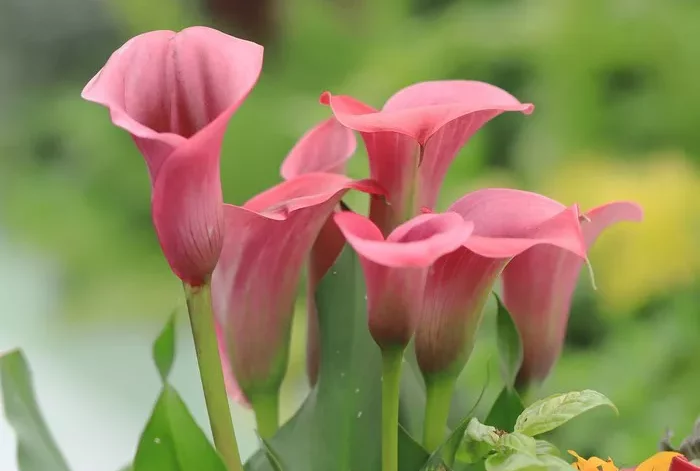In the world of flowers, few captivate the imagination and hearts of enthusiasts quite like the calla lily. Revered for its exquisite elegance and symbolic significance, this bloom stands out as a botanical masterpiece. As we delve into the fascinating realm of flora, it becomes imperative to understand the nuances that make the calla lily a true icon in the botanical landscape.
Botanical Profile
The calla lily, scientifically known as Zantedeschia, belongs to the Araceae family. Native to Southern Africa, these perennial plants are celebrated for their distinctive funnel-shaped flowers and arrow-shaped leaves. The genus Zantedeschia encompasses several species, with the Zantedeschia aethiopica being the most well-known and widely cultivated.
Morphology and Features: Unraveling the Aesthetics
The calla lily boasts a unique morphology that sets it apart from other flowers. The most striking feature is its inflorescence, often mistaken for a petal, known as a spathe. This modified leaf wraps around the central spike, known as the spadix, creating a visually arresting form. The spathe can display an array of colors, including pristine white, vibrant shades of yellow, pink, or even deep burgundy.
The inflorescence is not the only captivating element of the calla lily. The plant’s foliage, characterized by arrow-shaped leaves, adds to its allure. These leaves, typically glossy and dark green, contribute to the overall elegance of the plant. Understanding the intricate details of the calla lily’s morphology enhances our appreciation for its aesthetic appeal.
Cultural Significance: Beyond Beauty
Beyond its visual appeal, the calla lily holds significant cultural and symbolic value. Across various cultures and traditions, this flower has been endowed with diverse meanings. In Western societies, the calla lily often symbolizes purity, grace, and the divine. Its association with weddings and ceremonies underscores its role as a symbol of new beginnings and enduring love.
Conversely, in Eastern cultures, the calla lily is associated with concepts of resurrection and rebirth. The cyclical nature of life and death is reflected in the flower’s ability to bloom in favorable conditions and retreat in adverse ones. This dual symbolism adds depth to the calla lily’s cultural significance, making it a revered emblem in ceremonies and rituals.
Horticultural Insights
For horticulturists and gardening enthusiasts, cultivating calla lilies can be a rewarding yet nuanced endeavor. Understanding the plant’s specific requirements is essential for ensuring optimal growth and blooming. Calla lilies thrive in well-drained soil with a slightly acidic to neutral pH. Adequate sunlight, preferably partial shade, and consistent moisture are crucial factors that contribute to their flourishing.
Varieties and Cultivars: A Kaleidoscope of Choices
The world of calla lilies is not confined to a single variety. Horticulturists have bred numerous cultivars, each with its unique characteristics and charm. Some notable cultivars include the classic ‘White Giant,’ known for its large pristine blooms, and the mesmerizing ‘Black Star,’ featuring dark burgundy spathe and contrasting green spadix. Exploring the diverse palette of calla lily varieties opens up a world of possibilities for gardeners and floral enthusiasts alike.
Challenges in Cultivation
While calla lilies are known for their beauty, they are not without their challenges in cultivation. Understanding and addressing common issues, such as pests, diseases, and environmental factors, is crucial for maintaining the health and vitality of these plants. Adequate drainage, proper spacing, and vigilant monitoring can mitigate potential problems, ensuring a thriving calla lily garden.
Global Presence: Calla Lilies in Different Climates
The adaptability of calla lilies to various climates has contributed to their global popularity. From the temperate regions of North America to the tropical landscapes of Asia, calla lilies have found a home in diverse environments. Exploring their cultivation in different climates provides valuable insights into the versatility of these plants and the ways in which they adapt to varying conditions.
Culinary and Medicinal Uses
Beyond their ornamental value, calla lilies have found applications in culinary and medicinal realms. In some cultures, the tubers of certain calla lily species are used as a food source, with careful preparation to remove toxic compounds. Additionally, traditional medicine has explored the potential therapeutic properties of calla lilies, with research suggesting anti-inflammatory and analgesic effects. However, caution must be exercised, as certain parts of the plant can be toxic if ingested.
Conservation Efforts: Preserving the Beauty
As with many botanical wonders, calla lilies face threats from habitat loss, climate change, and human activities. Conservation efforts are underway to safeguard these plants and their natural habitats. Understanding the ecological importance of calla lilies and supporting conservation initiatives is crucial for preserving their beauty and ensuring their existence for generations to come.
Art and Literature: Inspirations from the Calla Lily
The calla lily’s allure extends beyond the world of gardening and biology, permeating art and literature. Renowned artists, including Georgia O’Keeffe, have immortalized the grace and sensuality of calla lilies in their works. In literature, the flower often serves as a metaphor for purity, femininity, and transcendence, enriching the symbolic tapestry woven around it.
Conclusion
In conclusion, the calla lily emerges as a botanical marvel that transcends its physical beauty. From its intricate morphology and diverse cultivars to its cultural symbolism and global presence, this flower invites us to explore the intersections of science, art, and culture. As we unravel the enigmatic beauty of the calla lily, we find ourselves immersed in a symphony of elegance, where each petal and leaf tells a story of resilience, grace, and enduring allure. In gardens, ceremonies, and the realms of inspiration, the calla lily stands as a testament to the profound connection between nature and human experience.


